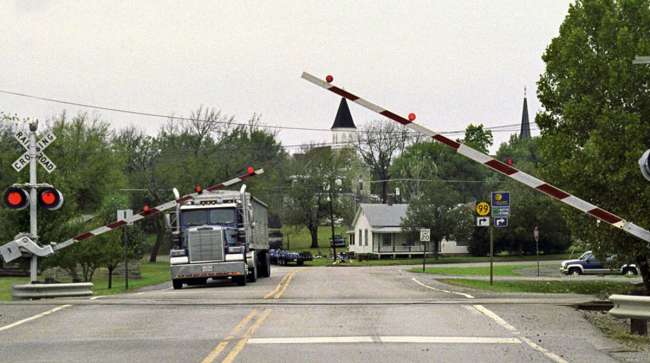Staff Reporter
FRA Final Rule Requires State Highway-Rail Grade Crossing Plans

[Stay on top of transportation news: Get TTNews in your inbox.]
The Federal Railroad Administration has issued a final rule requiring states to develop, or in some cases, update action plans for highway-rail grade crossings.
A highway-rail grade crossing is where a roadway intersects with railroad tracks at the same level or grade. There are more than 250,000 such crossings in the United States, according to the Federal Motor Carrier Safety Administration.
FRA has reported that 94% of all rail-related fatalities and injuries occur at railroad crossings or are the result of trespassing. More than 400 rail-related fatalities due to trespassing occur each year.
FRA-2020-26064 by Transport Topics
The final rule, published in the Federal Register on Dec. 14, requires 40 states and the District of Columbia to develop highway-rail grade crossing action plans. Additionally, the 10 states that previously made action plans would have to update them and report steps they have taken to implement those plans.
According to the Federal Register document, the action plans must identify crossings that have experienced recent and/or multiple incidents and present strategies for improving safety. Safety adjustments may include crossing closures or grade separations. Also, the final rule requires each state to designate an official to manage implementation of the action plan.
“The actions states must take to develop action plans and, more specifically, to develop specific strategies for improving grade crossing safety can, if done properly, significantly improve safety and complement other efforts by states to improve transportation safety generally,” the Federal Register document states.
The final rule stems from a provision in the Fixing America’s Surface Transportation (FAST) Act of 2015, which mandated FRA establish a rule requiring states to create highway-rail grade crossing action plans. FRA’s Notice of Proposed Rulemaking regarding the action plans was published in November 2019.
ICYMI: Our final rule requiring 40 states & DC to develop & execute #GradeCrossing action plans to improve public safety. Read more, including how 10 more states must update past plans & submit reports citing actions already taken: https://t.co/A87uabyTSg https://t.co/azz1EMHSwI pic.twitter.com/IlSkzzc1ID — The FRA (@USDOTFRA) December 15, 2020
An earlier bill, the Rail Safety Improvement Act of 2008, required 10 states to make these plans. This act directed the Secretary of Transportation to identify the 10 states with the most highway-rail grade crossing collisions between 2006 and 2008 and require those states to develop action plans that would identify safety improvements.
Using agency data on crossing incidents to form its determination, FRA required Alabama, California, Florida, Georgia, Illinois, Indiana, Iowa, Louisiana, Ohio and Texas to create action plans in 2010.
According to the Federal Register, FRA received public comments suggesting that federal funding should be available to states to help cover costs associated with developing the action plans. The Delaware Department of Transportation indicated the costs of developing an action plan would prohibit or delay the state’s implementation of safety improvements.
“DelDOT noted that the state of Delaware currently experiences an extremely low number of train-related crashes and asserted that developing an action plan would draw resources away from other ongoing efforts to make a positive safety impact on the state and its communities,” the document states. “Accordingly, DelDOT recommended that FRA establish guidelines that, if met, would exempt a state from the requirement to develop an action plan.”

In this special two-part year in review, we look at the technology and regulatory developments that will help you and your business in 2021. Transport Topics Reporter Eleanor Lamb and Managing Editor for Features Seth Clevenger discuss HOS, software, equipment and more. Hear a snippet, above, and get the full program by going to RoadSigns.TTNews.com.
The statutory mandate for the final rule does not contain any provision that would dedicate federal funding for the action plans. However, states may use funding allocated through the Federal Highway Administration’s Railway-Highway Crossings Program to develop and update their plans.
States must submit their plans to FRA for review and approval. Once approved, FRA is required by the FAST Act to make the plan publicly available on an “official internet website.”
If a state submits an action plan FRA deems incomplete or deficient, the FAST Act requires the agency to notify the state of the areas in which the plan is lacking. The state has 60 days to correct the deficiencies noted by FRA. If the state misses that deadline, the FAST Act requires FRA to post a notification online indicating the state has an incomplete action plan.
FRA representatives, including regional grade crossing managers and inspectors, are available to states as they develop and update their action plans. The agency will make highway-rail grade crossing incident data available to states upon their request and plans to provide webinars and technical assistance.
The final rule takes effect Jan. 13. States must submit their plans (or updated plans) to FRA no later than 14 months after the final rule’s publication date.
Want more news? Listen to today's daily briefing:
Subscribe: Apple Podcasts | Spotify | Amazon Alexa | Google Assistant | More




